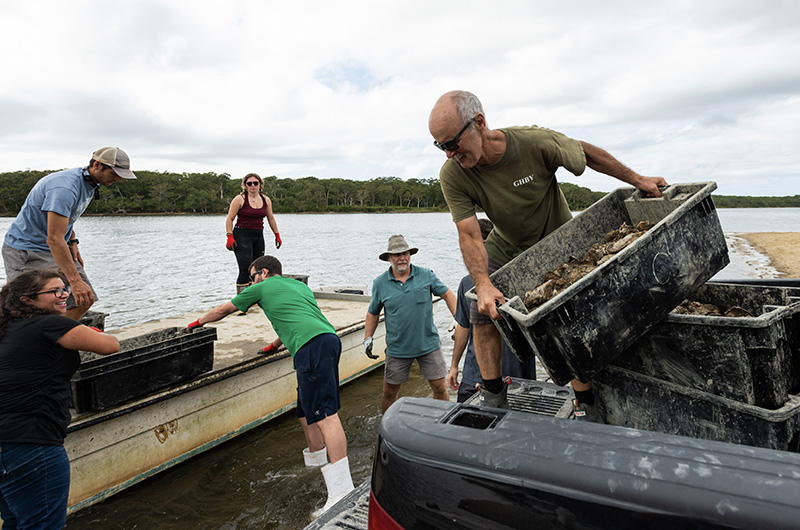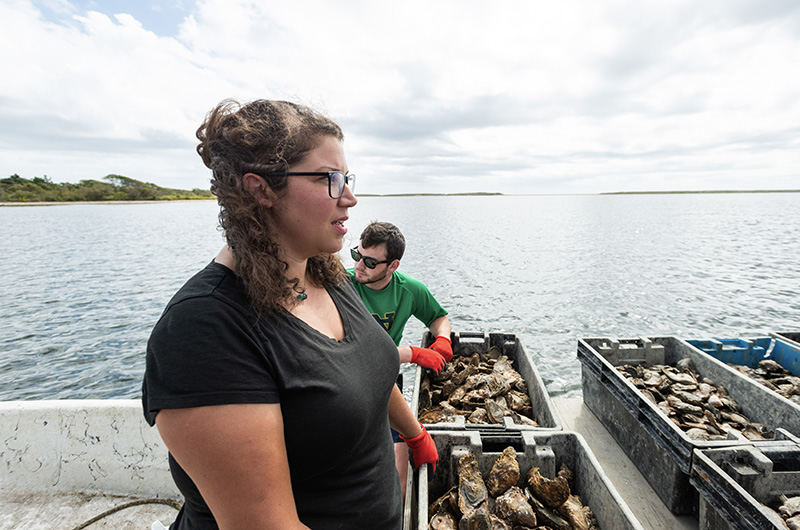Prior to the pandemic, Ryan Smith, whose Signature Oyster Farm operates out of Katama Bay, sold about 30,000 oysters per week — nearly all of which went to restaurants and raw bars across the Northeast.
By March of 2020, with in-person dining all but completely shuttered, the number dropped to about 300.
“Everything just halted,” the veteran waterman recalled. “I was selling door to door . . . it was terrible. You didn’t know how long it was going to last. But obviously, it lasted a lot longer than anybody could have anticipated.”
And as demand dwindled, the oysters themselves did the opposite, growing too large and gnarled for ritzy raw bars. Farmers like Mr. Smith were left with a fisherman’s catch-22, unable to sell the properly-sized oysters when restaurants closed, and unable to sell the oversized oysters once they reopened.
“I’ve got some that are the size of my boot,” Mr. Smith said. “I’m a size 12.”
Now more than 18 months later, an innovative partnership between The Nature Conservancy and the Martha’s Vineyard Shellfish Group has found a solution, providing a new home for 200,000 overgrown oysters by buying them from Mr. Smith and fellow Katama Bay oysterman Scott Castro at a discounted price and re-seeding them in the Slough Cove section of the Edgartown Great Pond.
Far more than just a culinary delicacy, oysters are natural filtration systems, capable of removing nutrients and pollution from more than 50 gallons of water per day — a bit more than a bathtub. And the bigger the oyster, the better the filter.
Both economical and ecological, the nationwide buy-back program — known as SOAR (Supporting Oyster Aquaculture and Restoration) — spawned out of the pandemic and a grant from the Pew Charitable Trust, with The Nature Conservancy promising to reseed five million oysters to improve water quality and rebuild shellfish grounds across the country, doling out more than $2 million to hundreds of struggling of oyster farmers along the way.
“Oyster farming is a really important part of the coastal economy, and these guys are really hurting,” said Steve Kirk, TNC’s coastal programs manager in the state. “Here’s a potential avenue for them to have another market.”
Because of its partnership with the shellfish group, TNC could expand the program to the Vineyard, knowing that marine biologists would monitor the reseeded oysters in the Slough Cove restoration site — a dedicated oyster sanctuary in the town of Edgartown. Both the state Department of Marine Fisheries, as well as NOAA, have extremely strict regulations about moving contaminated shellfish.
“You can’t just put oysters anywhere,” said Boze Hancock, a marine biologist for TNC who looks and sounds like the Crocodile Dundee of shellfish restoration. “Biosecurity is the big risk.”
After sending the oysters to a state lab for testing — and receiving the desired negative results — last week the shellfish group coordinated the oyster dumps in Slough Cove, watching the pond’s water quality improve below the surface, and the farmers’ quality of life improve above it.
“It’s so exciting for us, because we do so much work to put oysters into Edgartown Great Pond,” said shellfish group executive director Emma Green-Beach, standing at Wilson’s Landing as she waited for Mr. Smith and Mr. Castro to arrive. “That’s like 10 million gallons of water filtered per day.”
The program provides benefits beyond pond health. Oysters are protandric hermaphrodites, meaning they begin their lives as male and transition to female as they age. In turn, the larger the oyster, the more likely it is to be female — and the more likely it is to produce eggs. Enormous oysters, like
the ones purchased from Mr. Smith, can individually broadcast spawn more than 100 million eggs in a season, Ms. Green-Beach estimated. She didn’t even try to do the math to figure out how many eggs 200,000 could produce.
“We don’t have these huge animals putting out huge amounts of eggs. We are not getting the wild, natural recruitment and don’t have a good-standing stock for spawning,” Ms. Green-Beach said of the Edgartown Great Pond. “But now we are putting in all these good, spawning oysters, and I’m hoping that next year we see a good dose of recruitment.”
A healthy base layer of rock-like oyster formations — known as an oyster reef — can also create a habitat for other marine life, including blue crabs and striped bass.
“It’s kind of like putting soil in a garden,” Mr. Smith said. “Slough Cove is going to be one of the cleanest parts of that pond, for sure. The oysters are cleaning the water, and they are a landing pad for other shellfish.”
The Nature Conservancy — a global conservation nonprofit — has goals for the program beyond Covid, with Mr. Kirk and Mr. Hancock eyeing the potential for a long-term, alternative oyster
market outside the restaurant business. While oyster farming remains a profitable and growing waterfront industry, both agreed that it needs to diversify.
“Enough of the knee-jerk disaster relief,” Mr. Hancock said. “Is there something that the growers can plan into their business model, so that they have their half-shell market, and then their oversized market?”
“We want to improve water quality, and we want to provide habitat,” Mr. Kirk added. “We might be able to do this in an efficient way, with business.”
For Mr. Smith’s part, he’s just happy to be selling oysters again. And he’s thrilled they are going to Slough Cove.
“I live right over there,” he said. “It’s like hitting home.”









Comments (6)
Comments
Comment policy »